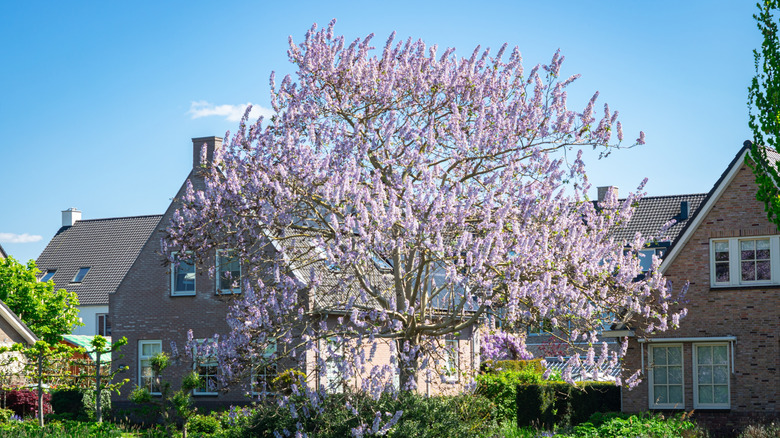Why The Popular Empress Tree Is The Last Plant You Want Growing Near Your Home
There's no debating that the empress tree (Paulownia tomentosa) is a stunning sight. With its flamboyant pink blooms and large stature, it's an aesthetically pleasing, flowing plant that can add drama to your yard or landscape. With its rounded canopy and large, heart-shaped leaves, the tree can provide ample shade, making it incredibly appealing to homeowners who are looking for a tree that grows quickly. In just 10 years, it can grow up to 50 feet tall and 30 feet wide, and its ability to self-seed makes it a practical, low-maintenance option for an open yard. But unfortunately, not everything that sounds good is good — this is one of the fast-growing trees that you definitely don't want to plant in your yard.
Despite its beauty and practical properties, the empress tree is highly invasive and won't go down without a fight. The tree is widely considered an aggressive invasive that can infiltrate stream banks, roadsides, and even woodlands. Additionally, its seeds travel easily, allowing it to spread far and wide without much effort. With just some wind and water, the empress tree can grow. It has a tough and quick-growing root system, which can extend into your neighbor's yard and beyond. It's extremely resilient, to the point where even fire and cutting the tree down isn't enough, as it has regenerative roots that can resprout from the root crown. So, while its beauty can certainly be tempting, the risks that come with the empress tree far outweigh the benefits. If you've already grown one on your property, it's important to take action quickly to mitigate problems as soon as you can.
How to get rid of the empress tree once and for all
Removing trees from your yard can get expensive, and unfortunately, removing the empress tree on your own is notoriously tricky. With its aggressive roots and resilient nature, the best approach is to avoid planting it altogether. However, if you already have one on your property, DIY removal is still possible as long as it hasn't gotten too large. Start by wearing safety gear, including gloves and eye protection. Use a handsaw to cut down the tree to less than 1 inch above the ground. Within five minutes, thoroughly apply a high-dose glyphosate-based herbicide with dye mixed in, allowing you to survey the area where the solution has been applied.
It can't be emphasized enough: if your tree has gotten too large, do not attempt to cut it on your own. Moreover, never attempt to even treat it in a place where there are people or property, as the dying tree can fall and seriously harm someone. But, if you've determined that the area is safe to proceed with chemically treating, you can move forward with a process known as girdling (versus cutting it down). To do this, use a saw to cut a complete ring around the bark until you see white sapwood. Next, spray a high-dose glyphosate-based herbicide into the cut to kill any remaining vegetation above the cut; then let time and gravity do their work.
Whichever removal method you choose, it will be important to monitor the tree for signs of regrowth to immediately do a follow-up treatment. But, with patience and the right application methods, you'll generally be able to get rid of this tree for good.

